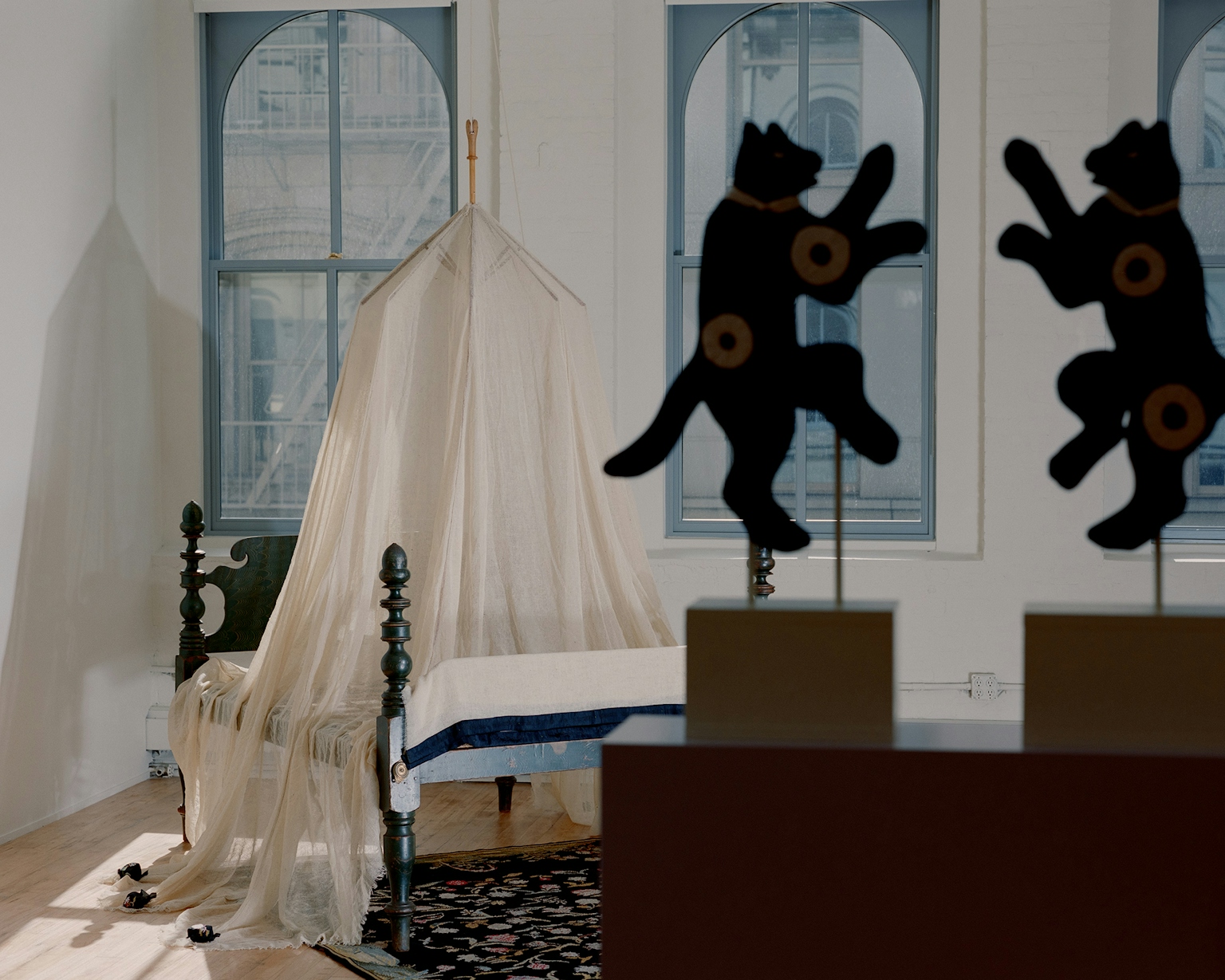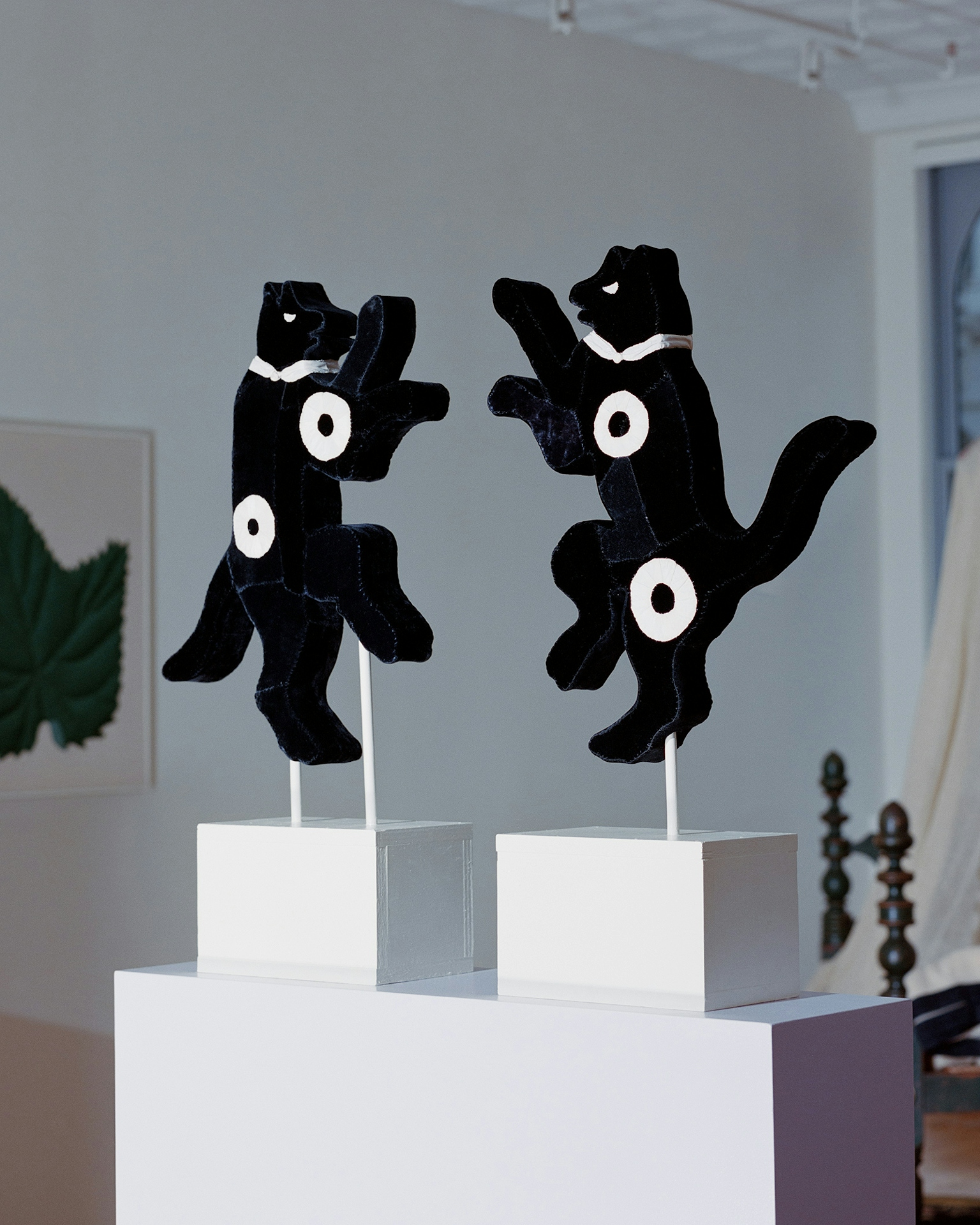
E.B: Where are you right now? And how are you doing?
E.C: I am in my apartment in Brooklyn and I’m good! I’m having a nice coffee.
E.B: In your own words, what do you do?
E.C: I would like to say I make things and I think about things.
E.B: How would you define your relationship to material? To me, it feels quite free. Is this an evolving relationship or one that’s always been a part of your creative practice?
E.C: I do feel like I have a free relationship with material. I always have, I think.
E.B: Where do you think that came from?
E.C: Many of my materials are ones that I’ve continued to use since I was little. At art school I bounced between majors because I had a hard time committing to a single medium. It feels natural to me to move between different materials to think through the same question or idea. I like to see how these works exist together dynamically as parts of the same world. That flexibility, or freedom, keeps me excited. It’s something I’ve followed and made space for.
E.B: I’m struck by the quiet and inviting sensory nature of your work: the internal sounds from the rattles; the analog fuzziness of the short films; the recurring use of tactile-rich media like plaster or fabric. Do you consider the sensory within your work?
E.C: Definitely. I’m interested in that more direct sensory aspect of the ceramic rattles, but also a broader sensory quality that comes from using materials that retain traces of their making, or making objects that show a history of tactile engagement, of layering and moving material. For me, engaging with the sensory brings up questions around what kinds of experiences or memories can be archived, recorded or shared, or what kind of presence can be made permanent.
E.B: Where did the rattles come from?
E.C: They came from an experiment that I ended up connecting with. It felt very lighthearted to me. I like seeing people pick them up and interacting with them when they aren't necessarily expecting them to make sounds. There’s that feeling of uncertainty as to how to interact with a piece of art or an unfamiliar object. Sometimes people almost look scared, like they might have just broken the piece. I really enjoy playing with that dynamic.

They have little clay balls inside them and because they're all different shapes they each make different sounds based on the way that the clay moves through their interiors. That specificity of the sound of each piece is also something that interests me.
E.B: Like a differently tuned instrument.
E.C: Yeah!
E.B: It’s nice to think about the experience of engaging with the rattles, which at first may be one of tension given the sounds of possible shards or broken bits. But then there’s the surprise in discovering something is inside, which isn’t not broken, but instead a vital element of this play-object.
E.C: Yeah, exactly.
E.B: What about their forms? They’re quite common with references to nature or other everyday things.
E.C: The first one I made was actually a little bunch of grapes. They’re all things that could kind of just be around the house. Something collected, like a shell, or something sitting on the table, like fruit. They're also all things that fit in your hand in a satisfying way. That’s an important part of it too.
E.B: To me, I see the influence of Folk Art throughout your work. While the paintings especially feel connected to this kind of cultural storytelling, I also see it across the sculptures and ceramics.
E.C: I'm definitely interested in objects that were made outside the scope of what has been called Fine Art, especially things with connections to domestic spaces and personal record keeping. I like looking at historical material culture, particularly from the pre-modern and ancient world. The idea of storytelling is also something that inspires me—trying to tell or read stories through objects or fragments.
E.B: In regards to your process, do you begin by referencing a specific kind of image or object from your ongoing research or is something that’s more broad and loose.
E.C: Often I’m inspired by more personal mythologies. Other times, if I see something that interests me, I try to find as many similar or related objects as I can and try to contextualize or understand a bit about how and where that thing would have existed and who experienced it. From there, the process of making in response to it is definitely looser and more abstract.

Untitled (Grape Leaf), 2023
E.B: Your first collaboration with JSG, Grape Soft Sculpture I, is not only one of the physically largest pieces that you’ve made, but it’s also a bit of a material departure especially in how it forefronts antique textiles. I’d love to hear where this piece emerged from in your story and how it relates to what you’re working on for Angle of Repose.
E.C: The soft sculpture wasn’t as much of a material departure as one of scale. I often use antique fabrics or millinery objects in my work. I like incorporating ephemera of domestic acts of making. The size of my sculptures, which are often smaller, has to do with responding at the scale of those fragments or smaller materials. When making Grape Soft Sculpture, I was interested in transforming those types of ideas and materials to a more monumental size. I was thinking about the bunch of grapes as a repeating image, with cross-cultural prominence over the course of millennia, filling the palaces of New Kingdom Egypt, frequently used in ancient Roman decorative schemes, dramatized in Baroque paintings, and continuing to appear frequently on mid 20th century tablecloths and doilies—to name just a few examples. I was interested in the monumental not just as it relates to scale, but also as a way of thinking about these kinds of images or ideas that persist with extended lives of meaning making.
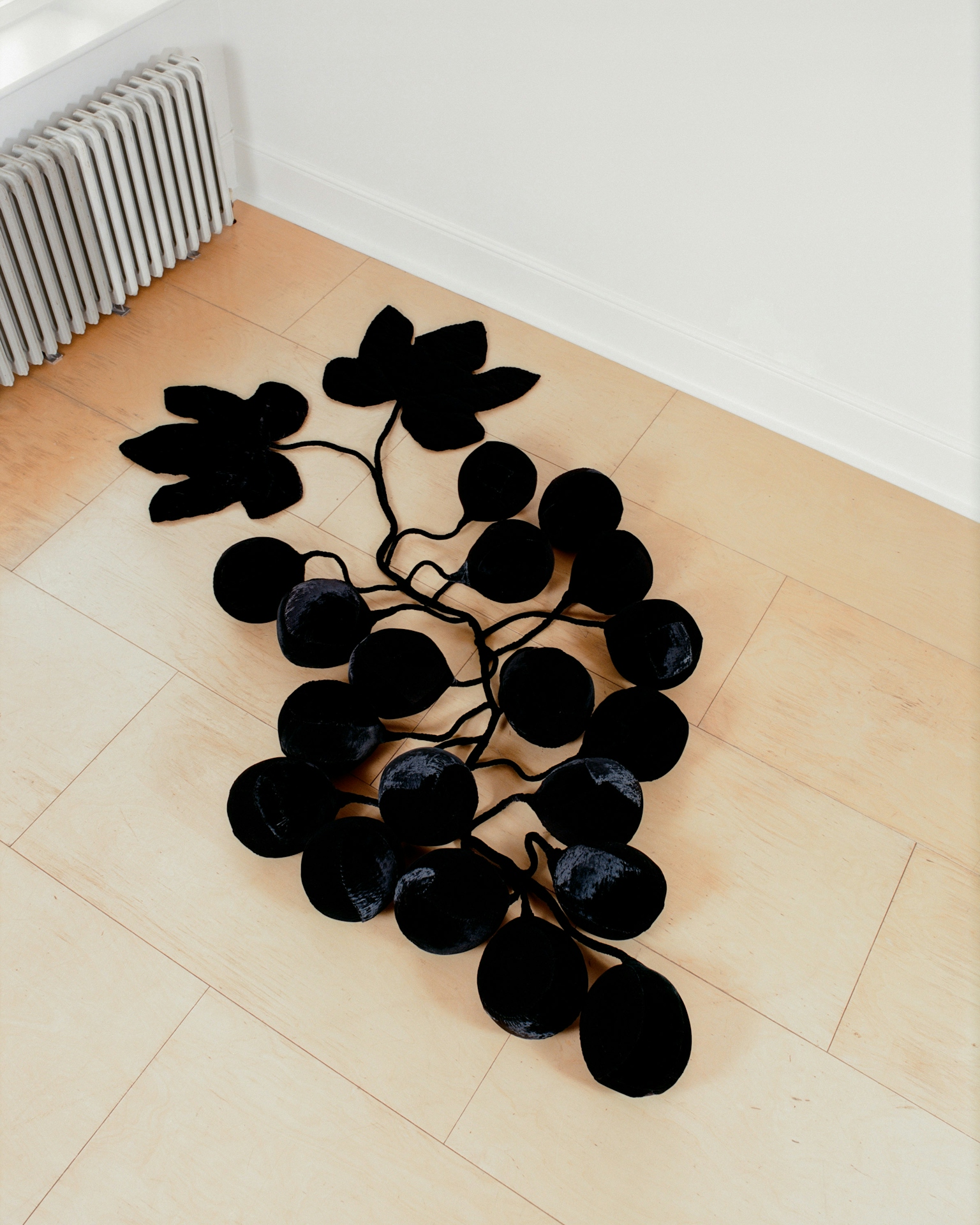
Grape soft sculpture
E.B: How did you feel when completing the piece?
E.C: When I was painting more, I always wanted the work to be as big as possible, so, in a way, it felt familiar to return to a large scale. Hand sewing something this size was physical in a very different way. It was also kind of a funny process building this piece in my apartment and eventually having to move the furniture around it as it grew to dominate my space.
E.B: Monumental is a really good word because it really does feel like this enticing, soft monument.
E.C: I was moving furniture around it to make space, but at the same time, the nature of this soft, floppy object is that it can also be moved around or draped over a chair. Because I made it, I guess I have the prerogative to move it around, but I was really interested to watch how carefully people approached it in the gallery. Of course I'm grateful for people being careful, but I do think that part of its potential is reconfiguration and interaction.
E.B: What was your entry point for the work in the exhibition? I’d love to learn a bit about its process and how you’re feeling about the work, right before the show opens and greets an audience.
E.C: I'm making three new sculptures. One’s a fabric grape leaf, which is made of vintage silk taffeta and backed with white silk moire fabric that will be hung and framed on the wall. The others are a pair of rearing dogs, also coated in fabric. I’ve often noticed this type of dog on early Renaissance pottery. These will be displayed like more traditional sculptures in that they're set on bases. I was continuing to think about transposing images or iconography across different materials. The work for the show also plays with ideas about softness and slump. So where the first large grape sculpture could be displayed in different ways—rearranged, piled, draped—the new grape leaf wall piece, while still feeling and looking soft, is sewed taught to its backing. The dogs are framed in wood and plaster but coated in layers of soft velvet and silk. Iconography that constantly repeats throughout history, like the grapes or the dogs, consequently brings with it morphing, ambiguous meaning. There’s something about structure or tautness that feels like an attempt to take narrative control in a struggle to keep the record straight in the face of time or memory.
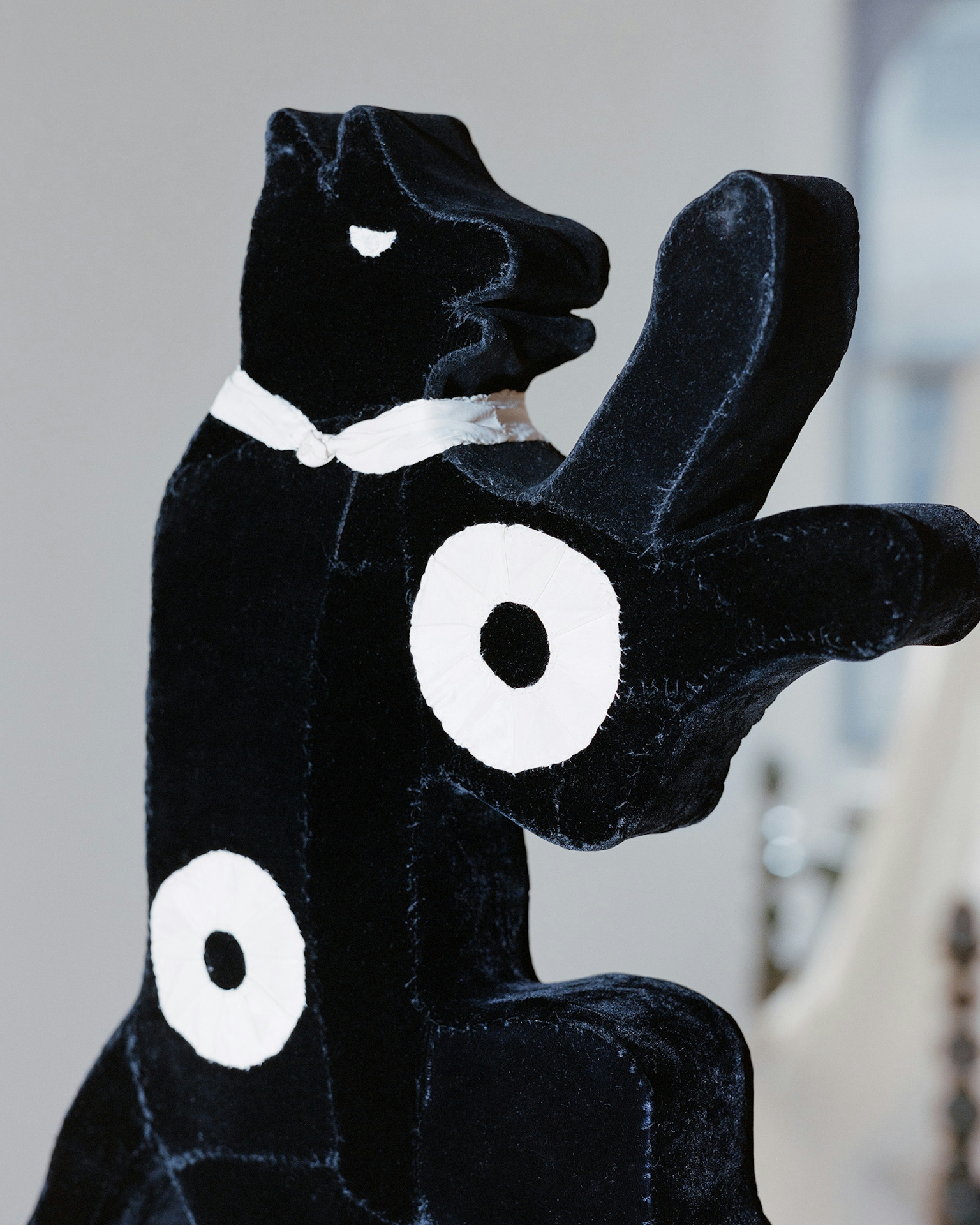
Untitled (Dogs), 2023
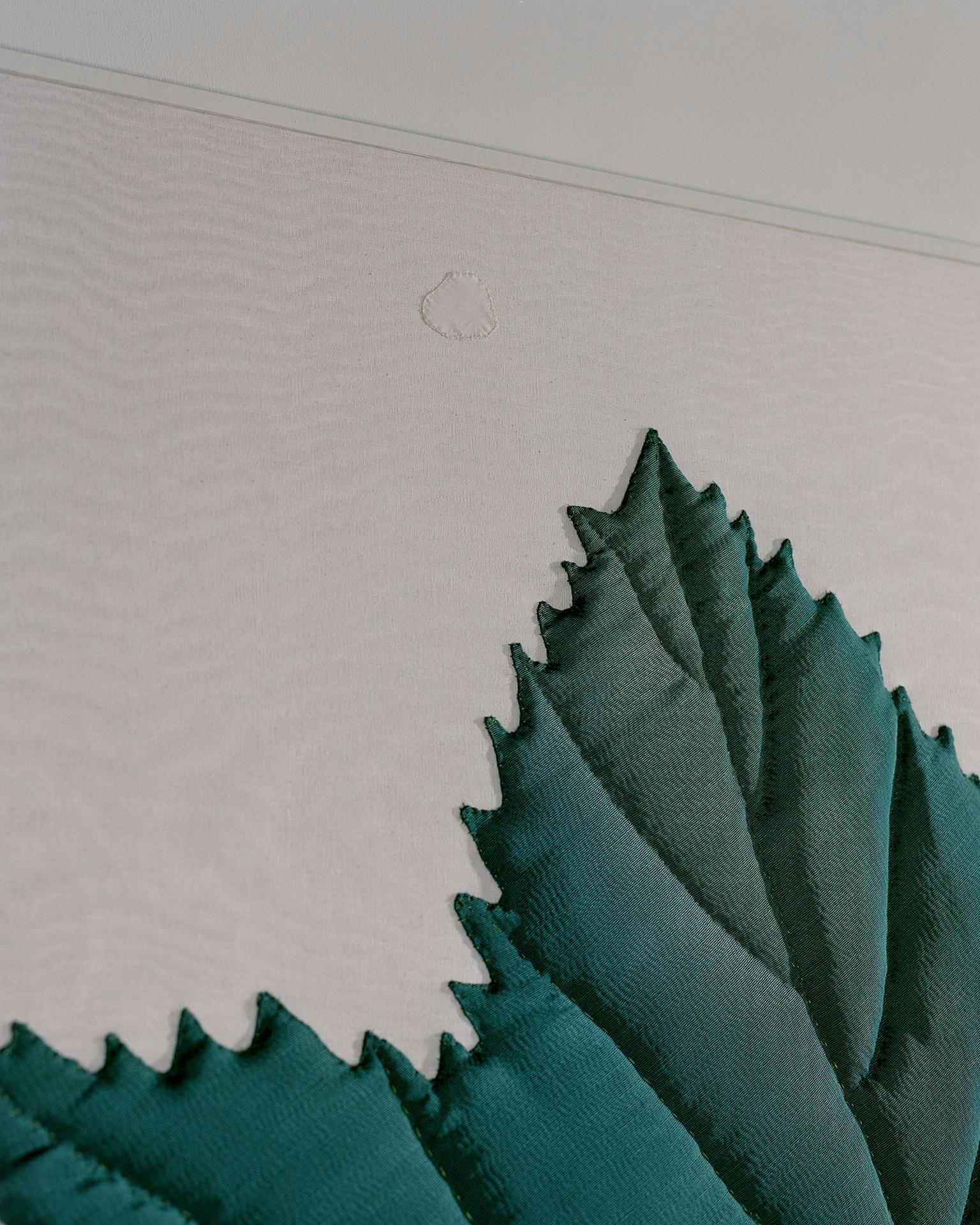
E.B: That's some nice presentational metaphor you have going on! Because the symbolism of these forms are trafficked across cultures and time, meaning slips into subjectivity. The rigidity of these new works feel like you’re staking a claim on defining their meaning for you in this instance. There's something nice about it as an act of confidence.
E.C: I'm thinking about archaeology, or looking at objects that are unearthed in a context that can’t ever be fully understood. There can be this kind of discouraging feeling of the impossibility of transmission, even from more recent time periods. Even if you were to read someone’s diary, there’s likely to be a sense of not really being able to understand the story accurately. There can be anxiety in the inability to pass on meaning in an accurate way. Though it’s okay to try to make an interpretation, important even. And maybe interpretation can be a stabilizing act.
E.B: How far along are you in the process? Are they all squared away or are you still finishing them?
E.C: I’m still working on them. They’re almost done. But because I do really like the process of layering and taking things apart and doing it again, it’s hard to feel like there's ever enough time. But it’ll be okay.
E.B: Yes, it will! Finally, what feels important to you as a human right now?
E.C: Trying to relax.
